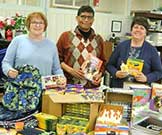|
|
 |
 |
Mansfield News Journal
City schools see rise
in homelessness
Courtney McNaull
March 14, 2017
MANSFIELD - The number of Mansfield City Schools students who don’t
have a place to call home is high and growing.
The district has already identified about 235 homeless students this
school year, a 14 percent increase over last year’s end-of-year total
of 207.
That means seven percent of the district’s students are identified as
homeless, and the count is likely to grow, according to Phil Mitchell
and Louise Yochheim, co-coordinators of the district’s Student
Achievement Through Family Engagement Program.
Mitchell and Yohheim, who are employed part-time through a federal
grant, will continue to add students to the list throughout the year as
students and families call for help or teachers refer students to the
program for services.
Some additional students will find themselves homeless by the year’s
end for reasons ranging from a parent losing a job and being unable to
pay rent to a high school student turning 18 and being shown the door,
Yohheim said.
The district’s homelessness count is based on the McKinney-Vento Act’s
definition of homelessness, which means a student lacks a fixed,
regular and adequate nighttime residence.
In Mansfield, just a handful of these children live in a homeless or
domestic violence shelter. About two-thirds live doubled-up with
extended family or family friends, often due to loss of housing or
economic hardship. Other homeless students live in motels or hotels. In
very rare cases, the district has found that a child and his or her
parents are living in a car.
Some of the students at the high school level have been kicked out of a
parent’s home for financial reasons or because of behavioral issues.
Other students have run away from bad situations at home or choose to
stay with another relative or a friend. These students may never tell
anyone at school about their living situation.
Mitchell estimates there could be 40 to 50 more students, especially in
older grades, who are without a stable home but haven’t been formally
identified as homeless.
Mitchell has not completed a breakdown by grade level for the current
school year, but last year, more than half of the district’s identified
homeless students were in kindergarten through third grade. Forty
percent of them went to Sherman Elementary School.
Once an identification is made, the S.A.F.E. program can connect
homeless students and their families to all kinds of resources. The
co-coordinators give out backpacks and school supplies, toiletries and
other household products like laundry detergent, toys and books and
information about where to get free clothes, hot meals, canned goods
and fresh produce. Everything they give away has been donated by
individuals, organizations and businesses in the community.
The program works with the school’s food service department to make
sure homeless students are getting free breakfasts and lunches, even
when they’re tardy. Homeless students are among the 82 percent of
Mansfield's students who receive free or reduced-price lunches.
Coordinators also work with the transportation department to ensure a
student can keep catching the bus as they move around and can continue
coming to their school of origin even if their family is staying in
another part of the district or even to another district.
Mitchell provides professional development for teachers and other
school staff to help them identify and support homeless students.
A retired teacher himself, Mitchell said his role with S.A.F.E. has
opened his eyes to the challenges homeless students face. A student may
not have his homework because he left it at his aunt’s house but he
unexpectedly stayed with his grandma the next night. A student may be
sleeping in class because her family is staying with so many other
people that it's too loud and chaotic to sleep at night.
The coordinators have helped parents find employment or housing, given
older students bus tickets to get to after school jobs, helped
18-year-olds find apartments through Catholic Charities and connected
students with college funding opportunities.
Last year, the program had grant-funded tutoring specifically for
homeless students, but this year, the funding for that has dried up,
Yochheim said.
National statistics show homeless children are twice as likely to score
lower on standardized tests than their peers. They're nine times more
likely to repeat a grade and four times as likely to drop out of school.
"There are certain things children need in order to learn, and we're
here to provide those things," Mitchell said. "We want to take away the
barriers that keep children from learning."
Read this and other articles at the Mansfield News Journal
|
|
|
|

